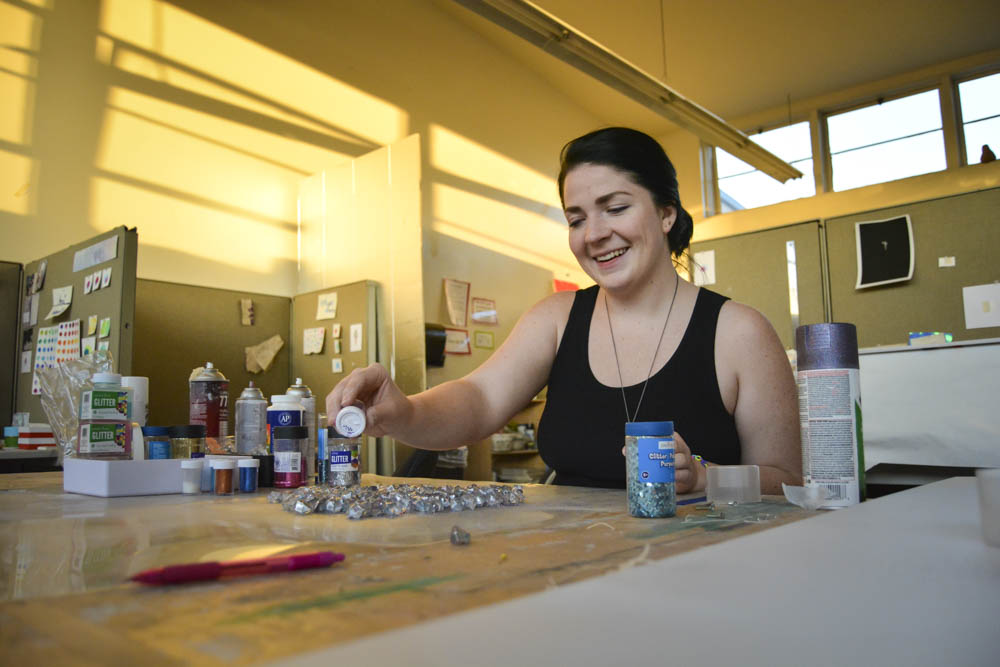Updated April 26 at 11:47 p.m.
Every year, graduating seniors fill the Earl and Virginia Green Art Gallery with installations of their own beautiful inventions.
Artists in the Bachelor’s of the Fine Arts program at Biola spend four years knowing their senior art projects will culminate in a week-long installment in the gallery. The senior seminar courses taken over two semesters provide ample time to conceptualize the show and present the concept to a panel of professors. Finally, the work of making their dream a reality begins with creating their pieces before the end of the artist’s senior year.
The process of setting up the art pieces in the gallery begins the Saturday before the artist’s assigned week of presentation. Artists take down their installations on Friday nights in order for the next week’s artists to have ample time to set up their pieces over the weekend, and prepare for the grand opening Monday night.
a feminist art show
Jessica Byrd, senior BFA with a graphic design emphasis, has been building her pieces since January. Her installation focuses on island imagery, the “deep female” and the many ways in which people perceive sexism and the human person. Her installation’s title will be “Uncharted Territory.”
“It’s a feminist art show, that’s what it is. So it’s a pairing of theological feminist thought as the root and birthplace of the issues in secular feminism,” Byrd said. “The root of my show and the root of the feminist theology in it is that we don’t see the God in woman, we don’t see the God in nature, so we’ve abused both.”
Byrd stressed that her conceptual art has roots in ideas of her own creation and also from seeing an idea and commenting on it through her pieces. While Byrd jumped headfirst into several mediums of art creation, Brianna Babcock, senior BFA with a design emphasis, formulated her concept through a watercolor experiment over the summer.
“What I loved the most about hearing about my show were people’s different interactions with it. It’s a very overwhelming wall, but in a very serene, peaceful way,” Babcock said. “My intent was to show that I was taking the same form and repeating it in different colors, and they’re all different. As a whole piece, it’s this big detailed thing. But then as you get closer, each one is actually its own little piece of work.”
thinking ahead
Even as freshman, those in the art program know they must prepare an installment show as seniors. While artists tend never to expect the viewer to fully understand the initial intention in a piece, Babcock emphasized, the diversity of readings only points to the diversity in viewership.
Noah Schrader, senior BFA with a design emphasis, pursued a similar kind of overwhelming installation. However, his medium of video to express his own experience with anxiety had a jarring effect, if it did not awaken some to better understanding. Schrader emphasized how he aimed to bring people greater awareness if not solidarity among those who suffer likewise.
“Anxiety has been something I’ve lived with my whole life, and I don’t let a lot of people in my life into that part of my life because of negative stigmas that come with mental illness,” Schrader said. “A big part of anxiety is that people that don’t experience it, it doesn’t make sense. It’s a really illogical thing to deal with, because it’s based on things that don’t make sense.”
conceptualizing suffering
Olivia Kincaid, senior design emphasis, also conceptualized suffering. Her art installation focused primarily on how the human being processes and cycles through grief and sorrow, though her individual paintings suggest joy and light-heartedness.
“I was looking at cycles, and resurrection into a healthier person, and how pain is beautiful. That’s why my paintings have this kind of weird twisted feel but then also I wanted to show the beauty in that pain and how it really does make you a better person, you just have to recognize that and keep moving forward with the steps,” Kincaid said.
While her installation focused primarily on sorrow, her interesting portrayal allowed viewers room for interpretation. Many labeled her use of pastel colors strangely Seuss-like, as her playful posters of pain exposed the many facets of recovery human beings experience through grief.
“I was looking at the different stages that I go through, and how one stage has to be fully gone through before you can go through the next one,” Kincaid said. “Oftentimes that’s kind of how life is, there is beauty in your art but it gets twisted somehow.”







